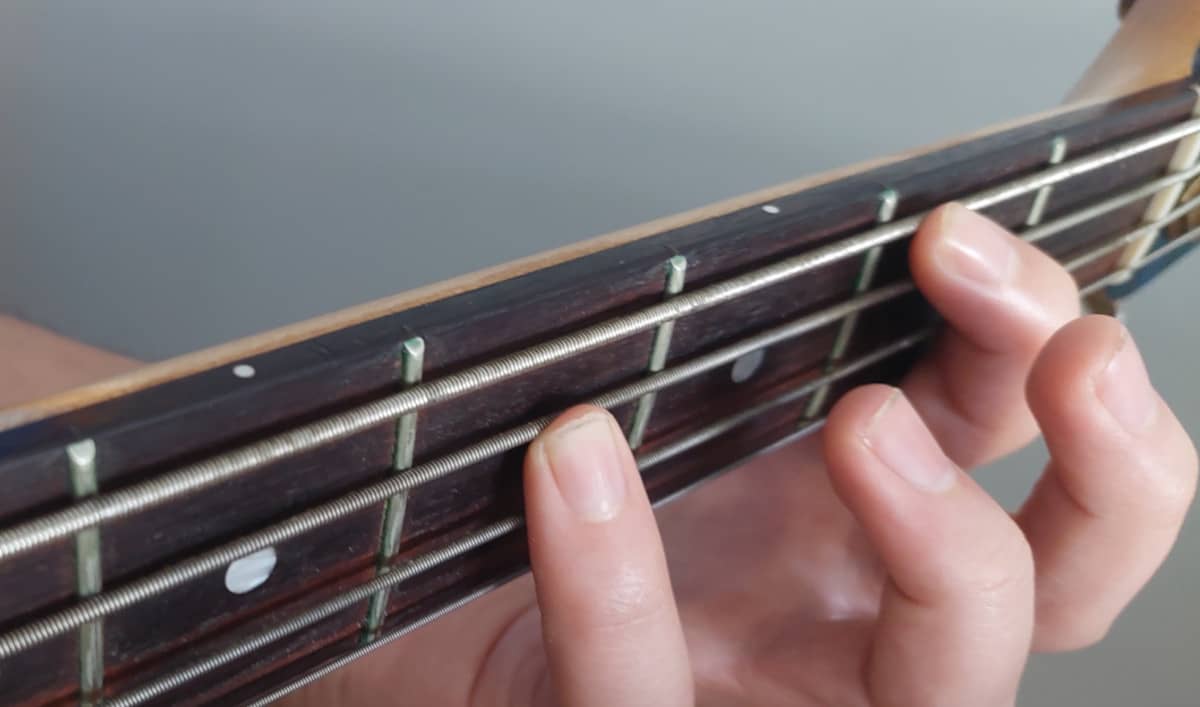The bass is generally not used to play power chords like the guitar is. Yet, power chords on tuned-down guitars sound good even when played at low frequencies with a lot of distortion. So what is stopping bassists from doing the same, and can you play power chords on the bass too?
It is possible to play power chords on the bass, just like the guitar. Power chords sound muddy at the lowest ranges of the bass and have a clearer sound when played higher up. Furthermore, turning down the lows on the amp makes power chords sound less boomy and indistinct.
So you can in fact play power chords on the bass, but it`s paramount that you go about it the right way.
I’ve utilized power chords in both metal and rock bands myself. Truthfully, I made some mistakes when I first tried it out and they did more harm than good at first. However, through the years I’ve learned how to use them to add both power and harmony to my playing.
Thus, I decided to write this article to show you everything you need to know about playing power chords on the bass. You will learn how to play power chords, why they often sound bad, and how you can avoid some common mistakes. I will also show you 10 different bassists who have used power chords to great effect.
How to play power chords on the bass
A power chord is played on the bass by playing a note, and it`s perfect fifth, 2 frets higher on the string above it. Playing a C at the 8th fret of the E string and a G at the 10th fret of the A string is a C5 power chord.
Power chords are one of the easiest bass chords to play for beginners. As long as you are playing in standard tuning, any chord with the following pattern is a power chord:
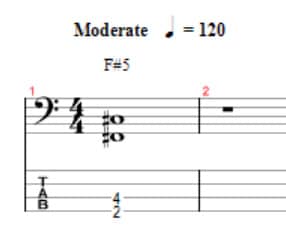
In my bass chord chart, I explain how this is a movable pattern. This means you can play this shape anywhere on the neck, and still have it be a power chord.
Furthermore, an octave on the string above can also be added to a power chord:
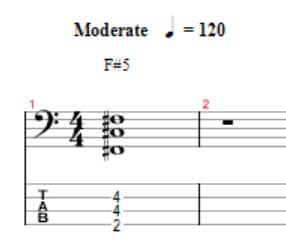
Some argue that a power chord only consists of the root and fifth. However, harmonically they are the same chord with and without the octave, and the term “power chord” is generally used interchangeably between them.
For most of the fretboard, I find it comfortable to play them with my index and ring finger. Occasionally, a power chord will be easier to play with the middle finger and pinky, depending on what notes preceded it. This is however rare.
At the deeper range of the fretboard, I find it more comfortable to use my index and pinky finger. I start gravitating towards this way of playing at around the 5th or 6th fret. If you are a bass player with small hands, you might find it more comfortable to do this at higher frets as well.
Where you do it, or whether you choose to do it all, should completely depend on your bass guitar, your physiology, and what feels comfortable.
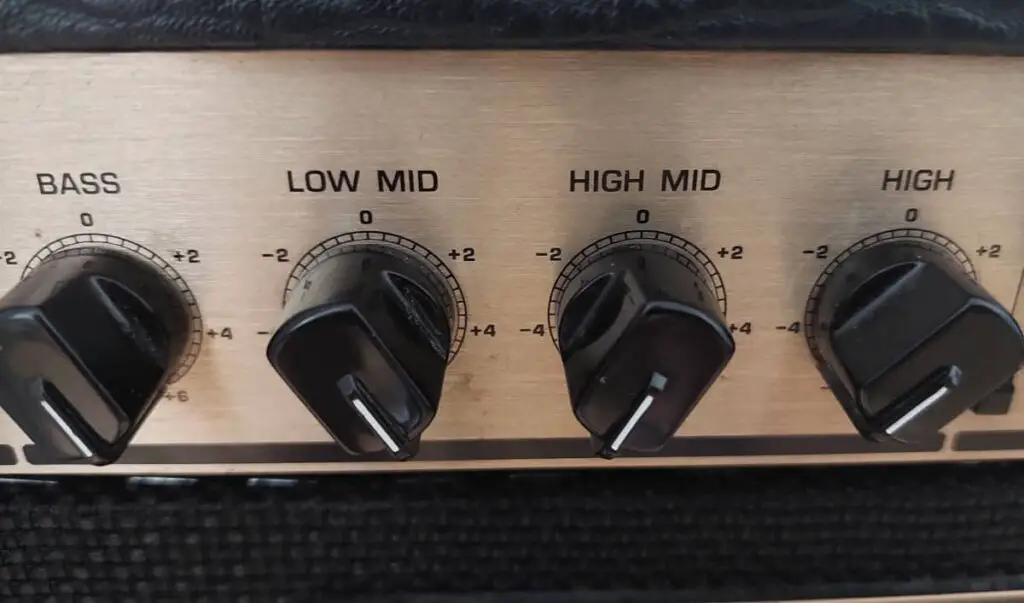
Why do my bass power chords sound bad?
Power chords can sound muddy on the bass because chords played at lower frequencies have a longer wavelength, which makes it harder to hear them clearly. Furthermore, the tone of a power chord can sound worse with unfit amp settings or poor strumming technique.
In my article on why bass chords sound muddy, I talk in-depth about a concept called lower limit intervals.
Simply put, all intervals have a low point at which the notes become indistinguishable. Thus, playing a perfect fifth, also known as a power chord under a certain pitch, results in it sounding muddy and blended together.
While lower interval limits are not universally agreed upon, the lower limit for a perfect fifth is generally accepted to be around C#1 – G#1.
This means that a power chord will be above the limit played anywhere on a 4-string bass in E standard, though deeper chords can still sound muddy. On a 5-string bass with a low B string, the lower limit is on the C# on the second fret:
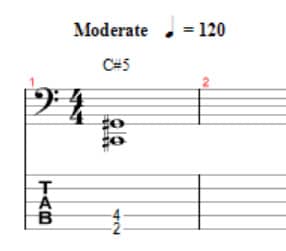
Any power chord played below this C# will be difficult to distinguish as individual notes. Staying right above the lower limit is also not advised, as chords will still be hard to distinguish, just not impossible.
Furthermore, it helps to use amp settings that give you a clearer bass tone. Turning up the highs and turning down the bass solves this, but will give you a weak tone overall. Thus, experiment with how low you can turn the lows and how high you can turn the highs, without losing your tone completely. As for the mids, you want them turned relatively high up.
Bassists who use power chords
Even though the bass is mainly played one note at a time, many bassists have utilized chords to great effect on the 4-string.
Power chords in particular have seen a good bit of use. They can make the bass sound heavier and more powerful, and have thus been used to great effect in genres such as rock, metal, and punk.
Here is a list of 10 bassists who have incorporated power chords into their playing, and how they did it:
| Bassist | Band | Song with power chords | Power chord being used |
| Les Claypool | Primus | John The Fisherman | B5, C5, C#5, D5, played low on the A, D, and G strings with an added octave as part of the main riff |
| Justin Chancellor | Tool | Schism | Slides up to a G5 on the A and D string as part of a riff. |
| Flea | Red Hot Chili Peppers | Snow (Hey Oh) | B5, F#5, C#5, played as chord progression high on the A and D strings. |
| Chris Squire | Yes | On The Silent Wings Of Freedom | E5 and A5 played on the A and D string as part of a riff. |
| Mark Hoppus | Blink-182 | Carousel | A5, B5, G5, played on the D and G strings as a chord progression. |
| Steve Harris | Iron Maiden | Powerslave | E5, C5, G#5, played on the A, D, and G strings with an added octave. Played as a chord progression to create buildup in the pre-chorus. |
| Peter Hook | Joy Division | Love Will Tear Us apart | A5 played on the D and G strings as the intro to the song and as part of the bass riff. |
| Fat Mike | NOFX | The Decline | F5, A5, C5, and G5, as the intro to the song and part of a riff. |
| Geddy Lee | Rush | The Pass | G5, A#5, F5, D#5, played on the A, D, and G string as the main riff of the song. |
| Lemmy | Motörhead | Ace of Spades | F#5 and C#5. Played both with and without an added octave on the A, D, and G string in Eb tuning as part of the verse. |
Conclusion
Like all types of chords, power chords are best used sparingly on the bass. However, in the right spots, they can completely elevate a song.
Unless you are looking for a muddy sound, make sure that you are playing them high enough, and never below a C#1. Experiment with your amp settings. Turn down the low end enough that your chords sound clear, but not so much that you’re only left with treble.
Listen to the songs listed above. They will give you lots of ideas on how you can incorporate power chords into your playing. Adding power, heaviness, or harmony are common ways to make great use of them. Power chords can also be used to play chord progressions or create buildup. They can even be used for the main riff of a song.
If you are looking to add heaviness to your playing, it’s a good idea to look into alternative tunings in addition to playing power chords. In my complete guide to D Standard tuning on the bass, I showcase the benefits of tuning down your instrument and how to do it properly.

